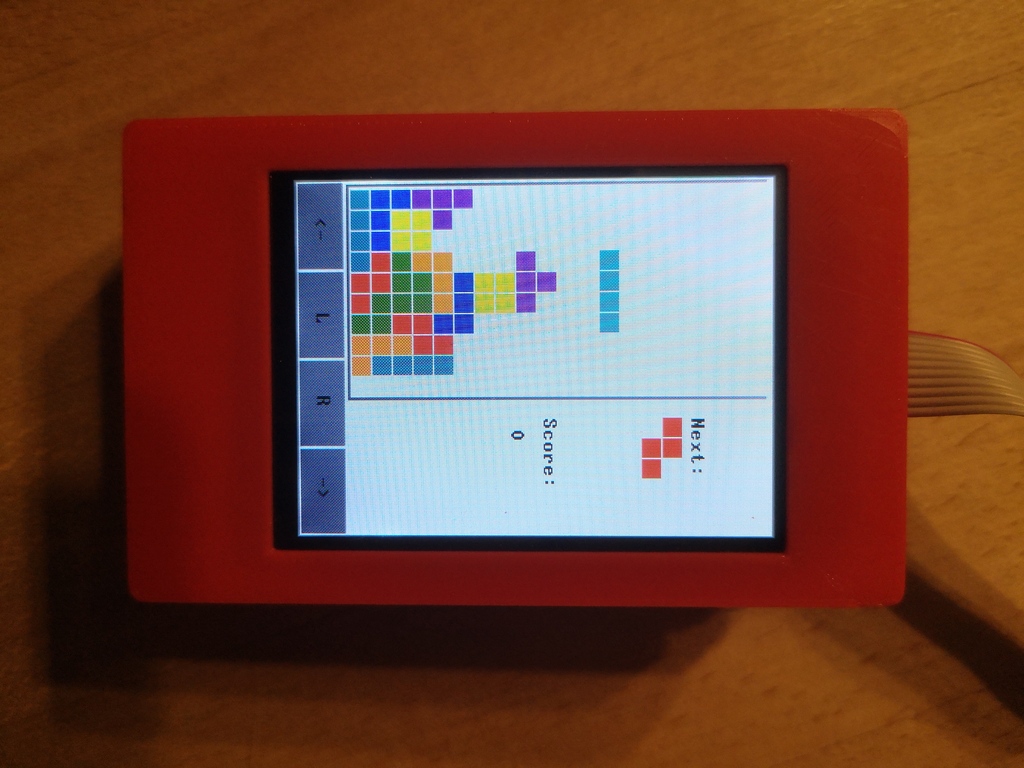nand2tetris-FPGA (v2.0)
... Would'nt it be nice to make Hack or Jack also run on some "real platform," made from some "real stuff"? ...
---Noam Nisan and Shimon Schocken
This project is about building HACK on real hardware as proposed in Chapter 13 of the course nand2tetris using only FOSS, free and open source hard- and software.
Our final implementation of HACK will have the following specs:
-
original CPU/ALU design of HACK from nand2tetris
-
implemented on iCE40HX1K-EVB from Olimex
-
clocked at 25 MHz
-
RAM 3840 x 16 bit (R0-R15/static/stack/heap)
-
SRAM 64K x 16 bit (instruction memory)
-
bootloader boots HACK-code from SPI-Flash into SRAM
-
2.8 inch color LCD with 320x240 pixel
-
touch-panel support
-
powerfull enough to run Tetris!
Roadmap
In every project folder you find a file Readme.md containing specifications and implementation details.
... This is your last chance. After this, there is no turning back. You take the blue pill — the story ends, you wake up in your bed and believe whatever you want to believe. You take the red pill — you stay in Wonderland and I show you how deep the rabbit-hole goes. ...
---Morpheus
00 Requirement
Get the hardware and install the tools.
01 Boolean Logic
Start with a simple Nand gate and build the logic chips: Not, Buffer, And, Or, Xor, Mux, DMux, and theire multibit versions Not16, Buffer16, And16, Or16, Mux16, Or8Way, Mux4Way16, Mux8Way16, DMux4Way and DMux8Way.
02 Boolean Arithmetic
Proceed and build HalfAdder, FullAdder, Add16, Inc16 and the ALU.
03 Sequential Logic
Build sequential chips Bit , Register and PC, that make use of the data flip flop (DFF) to store the state. DFF is considered primitive, so it's not necessary to implement it. The memory chips RAM512 and RAM3840 are based on the primitive RAM256, which uses block ram structures integrated in iCE40HX1K. BitShift9R and BitShift8L are new chips not explained in the original nand2tetris course. They serve to connect HACK to different IO-Devices, which are connected using a serial protocol, where data is transmitted bitwise.
04 Machine Language
Write two little machine language programms to run on HACK. The first programm leds.asm will test I/O capability of HACK. Every time the user presses the buttons BUT1/2 on the iCE40HX1K-EVB board the LEDs will change accordingly. With the second programm mult.asm we will calculate the product of two numbers to test the arithmetic capabilities of the CPU/ALU.
05 Computer Architecture
Build HACK computer system consisting of the chips CPU, Memory, Clock25_Reset20, RAM and ROM. ROM uses a block ram structure (256 words) of iCE40HX1K and can be considered primitive. It can be preloaded with the instructions of the assembler programs implemented in 04_Machine_Language .
06 IO Devices
We will expand HACK computer platform by adding chips to handle communication to I/O devices, which we connect to HACK.
- UART communicates with 115200 baud 8N1 to computer
- SPI reads the 2MByte flash memory on iCE40HX1K-EVB
- SRAM writes data to the external SRAM chip
- GO enables booting JACK-OS software
- LCD connects a little color screen with 320x240 pixel
- RTP connects the resistive touch panel
07 Operating System
Implement the operating system JACK-OS, written in the high level language JACK consisting of the classes GPIO.jack, UART.jack, Memory.jack, Math.jack, Array.jack, String.jack, Screen.jack, Output.jack, Touch.jack and Sys.jack
Finally you can compile and run Tetris!
08 3D Printer
We provide construction files to print a little case for your HACK computer with a 3D-Printer. The case is designed with FOSS software blender.
Credits
-
Noam Nisan and Shimon Schocken, "The Elements of Computing Systems", MIT Press
-
Noam Nisan and Shimon Schocken: Visit nand2tetris and learn to build a modern general-purpose computer system from ground up.
-
Olimex Ltd: Buy your hardware from the Company with highest number of registered OSHW projects :)
-
Wolf Clifford: The master of open source FPGA with iCE40 and Project IceStorm
-
Jesús Arroyo Torrens, Juan González (Obijuan): Open source ecosystem for open FPGA boards APIO
-
Juan González-Gomez (Obijuan): Lern verilog with open-fpga-verilog-tutorial, best tutorial!
-
Icons made by Those Icons from www.flaticon.com
For questions or comments write an email to mi.schroeder@netcologne.de

